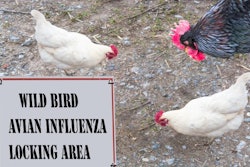
Eric Gingerich, DVM, technical services specialist, Diamond V, presented emerging disease issues in the organic layer industry at the Organic Egg Farmers of America’s Organic Egg Symposium in Minneapolis, Minnesota, on March 12, during the Midwest Poultry Federation Convention.
Gingerich explained 10 different problematic health issues facing the organic layer industry. Among those are:
1. False layer syndrome
False layer syndrome is difficult to diagnosis. Symptoms may include birds doing the “penguin” walk due to buildup of fluid in the left oviduct. Gingerich explained that producers usually will not see this issue until later in lay. There are no treatments, although, “producers can try to remove the non-layers, but this is hard to do,” he said.
2. Fowl cholera
This issue is caused by Pasteurella multocida. Lesions include liver spots and peritonitis. Production loss is high because mortality is high.
3. Spotty liver disease
Spotty liver disease is a serious problem in Australia. It was also seen in several pastured flocks in the Midwest during the summer of 2018. Its prevalence is believed to be associated with wet weather. Spotty liver disease can result in mortality rates of 1 to 2 percent per week and a loss of egg production of 5 to 10 percent. Oregano in feed or water, citric acid and chlorine can be used to stop the issue or slow it down.
4. Erysipelas
Gingerich explained that there have been many new cases this year in pastured layers of erysipelas. This disease results in high mortality of up to 4 percent a day. “Live vaccine has been found to work in chickens in face of the outbreak,” he said.
5. Gallibacterium anatis
Gingerich explained in a previous report that "Gallibacterium anatis septicemia seems to be increasing in prevalence, especially in the Southeast, although it has been seen it in the Midwest as well. It affects layers of all ages.” This is a typical septicemic disease that brings on acute death, Petechial hemorrhages and is often confused with E. coli infection. Mortality can be over 1 percent, per week. Shell abnormalities are also common.
6. Ulcerative dermatitis
Ulcerative dermatitis of brown cage-free layers is a problem that has been present in western Ohio since 2014. It has impacted various companies, but only brown layers. It results in high mortality. “The birds get an ulcer right in the middle of their back, and we’re not sure how it starts,” Gingerich said. It starts out small and gets bigger, like a flesh-eating bacterium. Rodents, insects, chemical irritants and wounding have all been ruled out as the cause. Antibiotics and disinfectant powders were not successful in helping with the issue. As the open area gets worse, the birds end up dying of E. coli.
7. Feed refusal
There is no evidence of feed refusal technically being an infectious disease. Mycotoxicosis are suspected as the cause of the issue. The problem is difficult to diagnose due to small pockets of toxin in feed, and tests might miss the toxins. “The key to regaining production is removing suspect feed quickly with good feed,” he said.
8. Egg drop syndrome
Egg drop syndrome is cause by an adenovirus. It results in loss of egg shell quality and pigmentation, according to Gingerich. Shell eggs are even a problem. White egg layers do not show signs, but can be infected. In 2018, the issue was detected in Pennsylvania.
9. Mycoplasma gallisepticum
Mycoplasma gallisepticum is a chronic respiratory disease. Morbidity may be minimal, and mortality varies. Signs include nasal and ocular discharge, coughing, and multiple others. Gingerich suggest on checking flocks at night to listen for respiratory issues.
10. Infectious coryza
Infectious coryza is caused by Avibacterium paragallinarum. Many backyard flocks are infected. A biochemical test is needed to identify the bacteria as aparagallinarum. There are several companies that produce vaccines to help with this. Birds have respiratory issues, mucoid discharge from nares, feathers stuck to nares and facial swelling.
In a separate presentation during the symposium also related to bird diseases, Yuko Sato, assistant professor at Iowa State University, explained that chicken sicknesses can look very much alike. “For definitive answers, you need to run additional testing,” she said.















